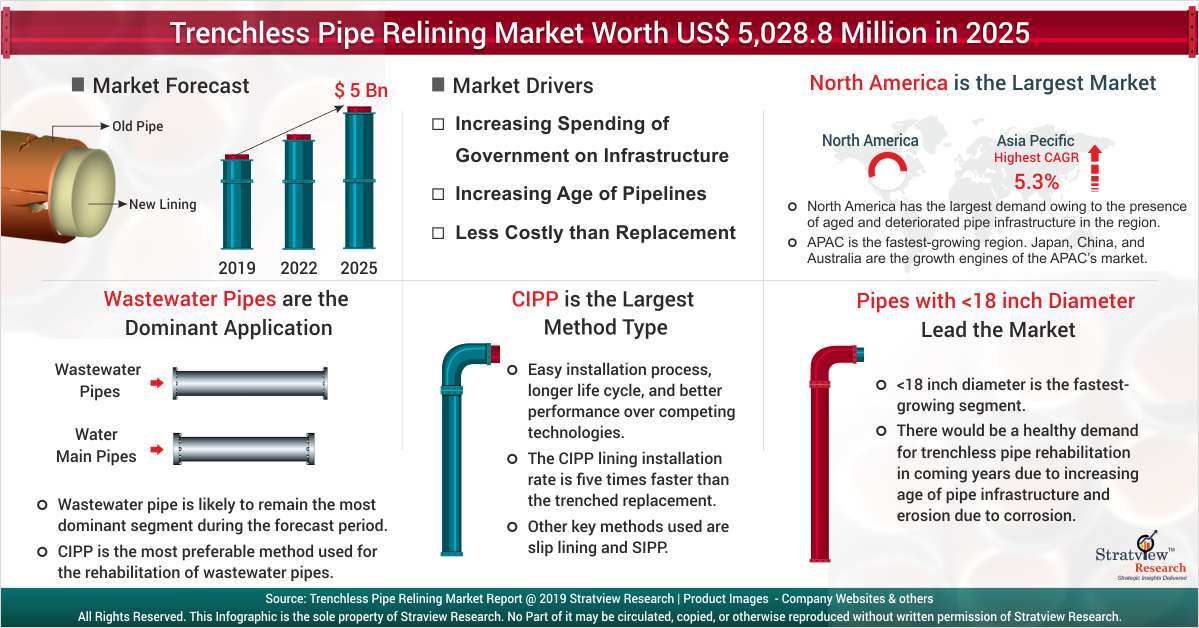Trenchless Pipe Relining Market
Contents |
[edit] Introduction
Trenchless pipe relining technologies are gaining traction in the global market, due to their outstanding performance and technical advantages. These techniques repair existing underground pipelines by inserting a relatively small diameter pipe or by spraying coating material into the damaged pipe to create a lining within the pipe, with very limited or no excavation.
The key features of these techniques are that the pipe relining has become faster, easier, cheaper, and cleaner. In addition, they avoid traffic jams, destruction of landscape, and other environmental impacts.
Ageing existing pipeline infrastructure, increasing deterioration rate, growing population, and urbanisation in the key countries, such as the USA, Germany, and Canada, have led to an increased focus on trenchless pipe relining techniques to reduce water loss and rehabilitate infrastructure while avoiding traffic jams and destruction of landscaping.
The USA alone has more than 9.5 billion feet of the installed pipeline of which most were laid in mid of the 20th century. Similarly, in the European Union states, around 23 billion feet of pipes are in operation from the last 100 years. In Japan, about 15% of water pipes have outlived their 40-year duration as of 2016.
The trenchless pipe relining market is projected to grow at an impressive rate over the next five years to reach an estimated value of US$ 5.0 billion in 2025. The market is mainly driven by an ageing existing pipeline network coupled with a surge in spending of government and municipal corporations to repair and maintain existing pipes.
[edit] Market by method
Based on method, CIPP is projected to remain the dominant as well as the fastest-growing segment in the market during the forecast period. The dominance of CIPP technology is mainly due to its fast and easy installation process, longer life cycle, and better performance over competing technologies. The CIPP lining installation rate is five times faster than the trenched replacement.
[edit] Market by application
Based on the application type, wastewater pipe is likely to remain the dominant segment during the forecast period. CIPP is the preferable method used for the rehabilitation of wastewater pipes. However, watermain pipe is expected to witness the highest growth during the forecast period. The equipment and liner materials used during relining have to be compliant under the certification and standards of NSF/ANSI 61, which has norms related to the material used for the lining of water main pipelines in order to prevent contamination of injurious substances of liners with the potable drinking water.
[edit] Regional analysis
In terms of region, North America is projected to remain the largest market for trenchless pipe relining during the forecast period. The average active service life of a pipeline installed is around 50 years and most have exceeded this. Relining provides an extension of around 30-50 years to the pipe.
Asia-Pacific is expected to witness the highest growth during the forecast period. Japan, China, and Australia are the growth areas of the Asia-Pacific's trenchless pipe relining market. These economies will generate demand to decrease water loss and improve water quality.
The supply chain for this market comprises raw material and equipment suppliers, trenchless pipe relining service providers/contractors, governments, municipal corporations, and public welfare societies.
Some of the key players in the trenchless pipe relining market are Aegion Corporation, Granite Construction Inc., Inland Pipe Rehabilitation LLC (IPR), Per Aarsleff A/S, and SAK Construction, LLC. The key customers of these players include state governments and local authorities of America, Federation of Canadian Municipalities, and Private Builders.
[edit] Related articles on Designing Buildings Wiki
Featured articles and news
RTPI leader to become new CIOB Chief Executive Officer
Dr Victoria Hills MRTPI, FICE to take over after Caroline Gumble’s departure.
Social and affordable housing, a long term plan for delivery
The “Delivering a Decade of Renewal for Social and Affordable Housing” strategy sets out future path.
A change to adoptive architecture
Effects of global weather warming on architectural detailing, material choice and human interaction.
The proposed publicly owned and backed subsidiary of Homes England, to facilitate new homes.
How big is the problem and what can we do to mitigate the effects?
Overheating guidance and tools for building designers
A number of cool guides to help with the heat.
The UK's Modern Industrial Strategy: A 10 year plan
Previous consultation criticism, current key elements and general support with some persisting reservations.
Building Safety Regulator reforms
New roles, new staff and a new fast track service pave the way for a single construction regulator.
Architectural Technologist CPDs and Communications
CIAT CPD… and how you can do it!
Cooling centres and cool spaces
Managing extreme heat in cities by directing the public to places for heat stress relief and water sources.
Winter gardens: A brief history and warm variations
Extending the season with glass in different forms and terms.
Restoring Great Yarmouth's Winter Gardens
Transforming one of the least sustainable constructions imaginable.
Construction Skills Mission Board launch sector drive
Newly formed government and industry collaboration set strategy for recruiting an additional 100,000 construction workers a year.
New Architects Code comes into effect in September 2025
ARB Architects Code of Conduct and Practice available with ongoing consultation regarding guidance.
Welsh Skills Body (Medr) launches ambitious plan
The new skills body brings together funding and regulation of tertiary education and research for the devolved nation.
Paul Gandy FCIOB announced as next CIOB President
Former Tilbury Douglas CEO takes helm.
UK Infrastructure: A 10 Year Strategy. In brief with reactions
With the National Infrastructure and Service Transformation Authority (NISTA).























